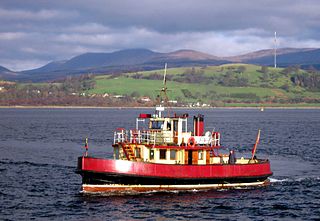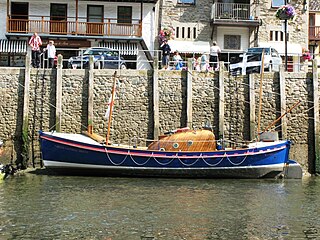
Red Funnel, formally the Southampton Isle of Wight and South of England Royal Mail Steam Packet Company Limited, is a ferry company that carries passengers, vehicles and freight on routes between the English mainland and the Isle of Wight. High-speed foot passenger catamarans, known as Red Jets, run between Southampton and Cowes, while vehicle ferries run between Southampton and East Cowes.

The Clyde puffer is a type of small coal-fired and single-masted cargo ship, built mainly on the Forth and Clyde canal, and which provided a vital supply link around the west coast and Hebrides of Scotland.

The Thames Ironworks and Shipbuilding Company, Limited was a shipyard and iron works straddling the mouth of Bow Creek at its confluence with the River Thames, at Leamouth Wharf on the west side and at Canning Town on the east side. Its main activity was shipbuilding, but it also diversified into civil engineering, marine engines, cranes, electrical engineering and motor cars.

Yarrow Shipbuilders Limited (YSL), often styled as simply Yarrows, was a major shipbuilding firm based in the Scotstoun district of Glasgow on the River Clyde. It is now part of BAE Systems Surface Ships, owned by BAE Systems, which has also operated the nearby Govan shipyard since 1999.

Rowhedge is a village in the Colchester borough of Essex, England. It is located just over 3 miles (4.8 km) southeast of Colchester town centre, and is part of the civil parish of East Donyland.

Hythe Pier, the Hythe Pier Railway and the Hythe Ferry provide a link between the English port city of Southampton and the Hampshire village of Hythe on the west side of Southampton Water. It is used both by commuters and tourists, and forms an important link in the Solent Way and E9 European coastal paths.

MV Kenilworth is a historic passenger ferry built in 1936 as MV Hotspur II. She was used on the Hythe Ferry service across Southampton Water until 1978, and then on the Kilcreggan ferry on the Firth of Clyde until 2007.

The MV Hotspur IV is a historic passenger ferry, which previously operated on the Hythe Ferry service. This service connects the town of Hythe and the city of Southampton, across Southampton Water in England.

William Denny and Brothers Limited, often referred to simply as Denny, was a Scottish shipbuilding company.

A & J Inglis, Ltd, was a shipbuilding firm founded by Anthony Inglis and his brother John, engineers and shipbuilders in Glasgow, Scotland in 1862. The firm built over 500 ships in a period of just over 100 years. Their Pointhouse Shipyard was at the confluence of the rivers Clyde and Kelvin. They constructed a wide range of ships, including Clyde steamers, paddle steamers and small ocean liners. In wartime, they built small warships, and in the period after World War II, they built a number of whalers.
RNLB Guide of Dunkirk was a 35ft 6in Self-righting motor-class lifeboat whose construction was funded by the Girl Guides in 1940. She was self-righting and designed for launching from a beach. As one of the Little Ships of Dunkirk she was used in the evacuation of Allied soldiers from Dunkirk in World War II. Between 1941 and 1963 she was stationed in Cadgwith, UK as a lifeboat. In 1963 she passed into private ownership.
Cruiser is a passenger vessel owned by Clyde Marine Services Ltd operating in the River Clyde as part of the company's charter cruise fleet. Her former names are Southsea Queen, Hythe Hotspur and Poole Scene.

The Gosport Ferry is a ferry service operating between Gosport and Portsmouth in Hampshire, southern England. It is currently operated by Gosport Ferry Ltd, a subsidiary of the Portsmouth Harbour Ferry Company Ltd, itself a wholly owned subsidiary of FIH group plc.

The Port of Southampton is a passenger and cargo port in the central part of the south coast of England. The modern era in the history of the Port of Southampton began when the first dock was inaugurated in 1843. The port has been owned and operated by Associated British Ports since 1982, and is the busiest cruise terminal and second largest container port in the UK.
Twickenham Ferry was a train ferry built in 1934 for the Southern Railway. She served during the Second World War as a minesweeper and returned to merchant service post-war, serving until 1974 when she was scrapped.

Sioux was a steamship which was operated on Puget Sound and the Strait of Juan de Fuca from 1912 to 1941. From 1924 to 1941, following reconstruction, the vessel operated as an auto ferry under the name Olympic. During the Second World War (1941-1945) this vessel was taken under the control of the U.S. Army and renamed the Franklin R. Leisenburg. The Liesenburg served as a ferry in the Panama Canal area under Army control, and then was sold to a firm which ran the vessel on the Surinam river in South America.

The Liverpool-class lifeboat was a non self-righting boat operated by the Royal National Lifeboat Institution (RNLI) from its stations around the coast of the United Kingdom and Ireland. The boats were designed for carriage launching and there were two types built, single and twin engined.
The Victualling Inshore Craft, or VIC, was a type of auxiliary vessel built for the Royal Navy during the Second World War. The VIC was modelled on the Clyde puffer, and over 100 were built during the conflict.















